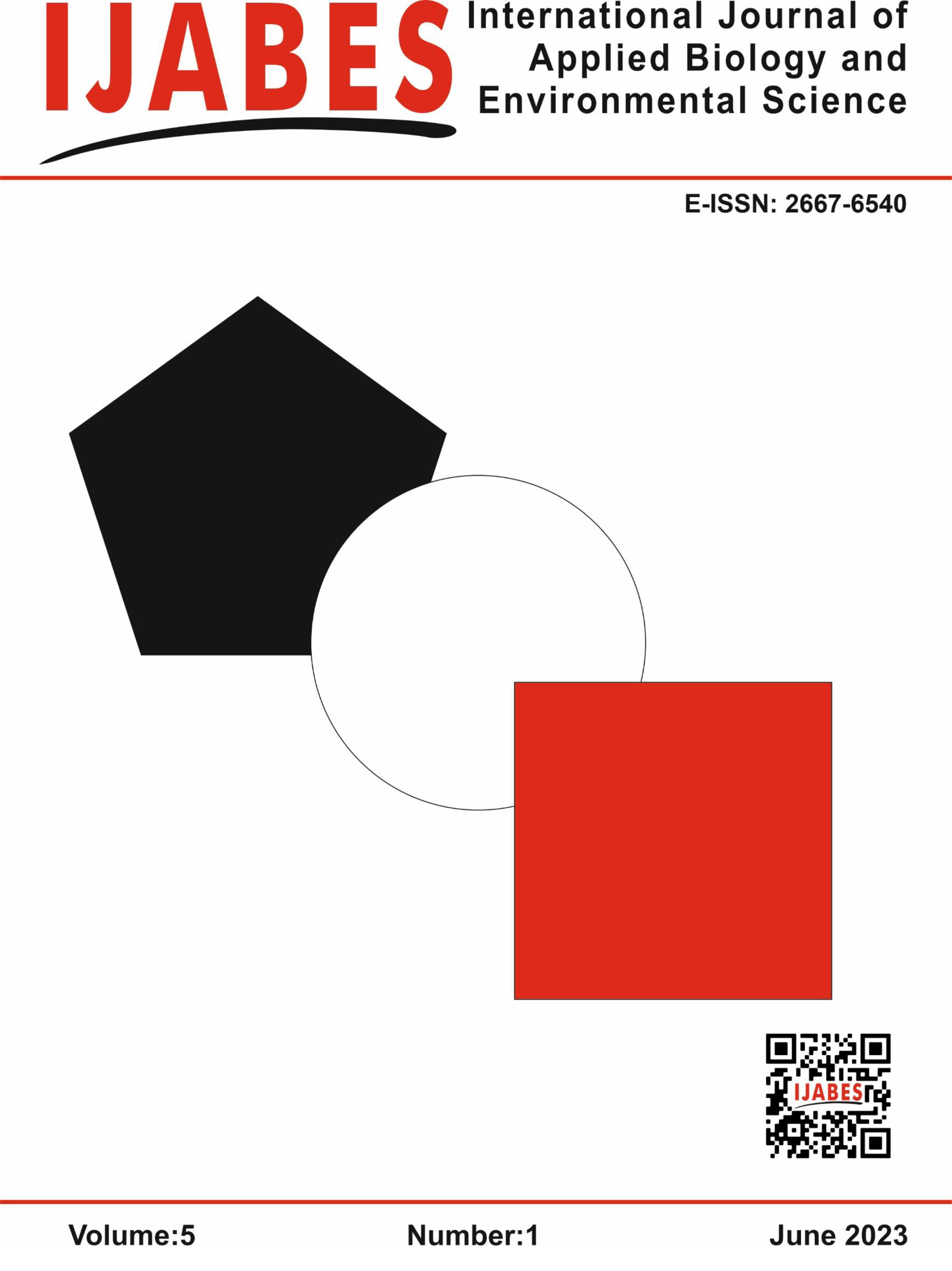








Yayımcı adresi: Hadımköy TOKİ Mevlana Cd. B1/2 D:2
Hadımköy / Arnavutköy / İstanbul

This work Licensed under the Creative Commons Attribution 4.0 International License.
Volume: 3 Issue: 1 - 2021
| 1. | Cover Page I |
| 2. | Contents Pages II - III |
| ORIGINAL RESEARCH | |
| 3. | The influence of biomass and species extracts of Ganoderma P. Karst on the seeds germination and the growth of Lepidium sativum L. Danylo Boromenskyi, Nina Bisko, Galeb Al-maali doi: 10.5505/ijabes.2021.87487 Pages 1 - 5 To determine the allelopathic effects of mycelial biomass of investigated strains was used a modified sandwich method: between two layers of agar medium was added 0.1 g of dry crushed biomass, followed by the introduction of seeds on the top layer. To determine the effect of methanol and ethyl acetate extracts, extract - soaked filter paper discs in sterile Petri dishes were used, to which 2 ml of sterile water was added after evaporation of the solvents, then seeds were added. Aqueous were adjusted to 2 ml with sterile water and impregnated the filter paper discs, after which the seeds were added. Biomass of all investigated strains shows allelopathic influence: the strongest - mycelium G. tsugae Murrill 2024 - inhibits plants growth by 80.9%, the weakest - G. carnosum Pat. 2502 - inhibits plants growth by 30.7% compared to control. Addition of 20 μl of G. sinense J.D. Zhao, L.W. Hsu & X.Q. Zhang 2516 aqueous extract stimulates shoot growth compared to the control by 19.3%. Ethyl acetate extracts of G. tsugae 2024 showed the highest allelopathic influence, which increased with increasing concentration of the extract - at a concentration of 100 μl, plant growth was inhibited by 100%. |
| 4. | Comparision of Antibiotic Susceptibility Percentage of Acinetobacter spp. Strains Obtained From Clinical Samples in Muğla, Turkey Nur Ceyhan Güvensen, Dilek Keskin, Funda Sankur doi: 10.5505/ijabes.2021.99608 Pages 6 - 8 Çalışmanın temeli: Acinetobacter spp. gram negatif bir basildir ve özellikle Acinetobacter enfeksiyonlarından kökenlendiği en önemli ortamlar hastanelerdir. Amaç: Bu çalışmanın amacı, Ocak 2015 ile Aralık 2015 arasında çeşitli klinik örneklerden (trakeal aspiratlar, kan ve idrar) izole edilen Acinetobacter'in antibiyotik direnç oranlarını belirlemektir. Yöntemler: Yeni BD Phoenix otomatik mikrobiyoloji sistemi, otomatik hızlı antimikrobiyal duyarlılık testi olup klinik olarak ilgili bakterilerin tanımlanmasında kullanılmaktadır. MIC değerlerini belirlemek için mikrodilüsyon yöntemi kullanılmıştır. Duyarlılık sonuçları 2012 EUCAST kriterleri kullanılarak değerlendirilmiştir. Bulgular: Sonuçta, izolatların ampisilin-sulbaktam, imipenem, meropenem, sefepim ve siprofloksaksine duyarlılıklarının en yüksek (% 71), trimetroprim / sülfametoksal ve gentamisine (% 25) duyarlılıklarının en düşük olduğu ortaya koyulmuştur. En etkili ilaç kolistin olarak bulunmuştur. Tüm 7 adet Acinetobacter spp. suşu, on antibiyotiğe Çoklu Antibiyotik Direnci (MAR) göstermiştir. Tartışma: En uygun antimikrobiyal tedavinin seçimi için antibiyotik duyarlılık testi sonuçları dikkate alınmalıdır. Ampirik tedaviyi belirlemek amacıyla, yüksek antibiyotik direncinde iyi bir dirençlilik profili bilgisi gerekir. Background: Acinetobacter spp. is a gram negative bacilli and very important hospital environment especially treating of Acinetobacter infections. Purpose: The objective of this work was to determine the antibiotic resistance rates of Acinetobacter spp. isolated from various clinical specimens (tracheal aspirates, blood and urine) between January 2015 and December 2015. Methods: The new BD Phoenix automated microbiology system is designed for automated rapid antimicrobial susceptibility testing and identification of clinically relevant bacteria. The microdilution method was used to the MIC values. Susceptibility results were evaluated using 2012 EUCAST criteria. Results: The recent results revealed that susceptibilities of the isolates to ampicillin-sulbactam, imipenem, meropenem, cefepime and ciprofloxacin were highest (71 %) while susceptibilities to trimetroprim/sulfamethoxale and gentamycin (25 %) were lowest. Colistin was found to be the most effective drug. All of 7 Acinetobacter spp. strains showed Multiple Antibiotic Resistance (MAR) to ten antibiotics. Conclusion: Antibiotic susceptibility testing results should be considered for selecting optimal antimicrobial therapy. High antibiotic resistance demands a good knowledge of resistance profile in order to determine empirical treatment. |
| 5. | Preliminary Study on Determination of Ephemeroptera Species of Gordes (Manisa) And Its Surroundings Tuğrul Öntürk doi: 10.5505/ijabes.2021.32042 Pages 9 - 10 Benthos samples were collected in 2019 from 5 previously determined stations on Gördes Stream. The samples were collected with the help of a scoop and sieved in 60 and 80 mesh sieves. As a result of the study, 7 taxa from Ephemeroptera were determined. |
| 6. | The Effect of Boric Acid on Tissue and Enzyme Activity in Eisenia Fetida Mustafa Uyanoğlu, Özge Turgak Kaydıhan doi: 10.5505/ijabes.2021.92400 Pages 11 - 17 Ülkemiz bor zenginliği açısından dünyada lider konumdadır ve bor bileşikleri çok sayıda endüstriyel ve tarımsal amaçla kullanılmaktadır. Bu kadar geniş bir kullanım alanına sahip olmasına rağmen canlılar üzerindeki etkileri ile ilgili çalışmalar sınırlıdır. Mevcut deneysel çalışma 10 grup (her grupta 10 adet Eisenia fetida toprak solucanı) içerecek şekilde planlanmıştır. Çalışma iki kontrol grubunu içeriyordu; negatif kontrol grubu (Grup I) ve pozitif kontrol grupları (Grup II, III ve IV). Pozitif kontrollere üç farklı dozda kadmiyum nitrat tetrahidrat uygulandı. Grup V, VI ve VII, üç farklı dozda borik asit ile maruz bırakıldı. Deneysel habitatlarda 7 gün süreyle gerçekleştirilen uygulamaların sonunda ışık mikroskobu kullanılarak bağırsak epiteli ve klorojenik dokunun histopatolojisi değerlendirildi. Transmisyon elektron mikroskobu (TEM) incelemelerinde bu dokulardan alınan hücreler hem mitokondriyal hem de düz endoplazmik retikulum (ER) yapısal değişiklikleri ile glikojen ve lipid damlacıkları birikimleri açısından değerlendirildi. Katalaz (CAT) ve glutatyon peroksidaz (GPx) enzimlerinin aktiviteleri de doğal jel elektroforez tekniği kullanılarak incelendi. Elde edilen bulgular, test edilen bor bileşiğinin sadece yüksek miktarda kullanıldığında toksik etkilerinin kadmiyumdan daha yüksek olduğunu ortaya koymuştur. Borik asit, kadmiyum kadar zehirli değildi. Our country is the leader in terms of boron richness in the world and boron compounds are used in numerous industrial and agricultural purposes. Although it has such a vast area of use, studies on its effects in living things are limited. The present experimental study was planned composing of 10 groups (each group contained 10 Eisenia fetida earthworms). The study included two control groups; negative control group (Group I), and positive control groups (Groups II, III and IV). Positive controls were administered three different doses of cadmium nitrate tetrahydrate. Groups V, VI and VII were exposed with three different doses of boric acid. At the end of the applications, conducted for 7 days at experimental habitats, intestinal epithelium and chlorogenic tissues histopathology were evaluated by using light microscope. In transmission electron microscope (TEM) examinations, the cells taken form these tissues were assessed regarding to both mitochondrial and smooth endoplasmic reticulum (ER) structural changes with glycogen and lipid droplet accumulations. Activities of catalase (CAT) and glutathione peroxidase (GPx) enzymes were also examined by using native gel electrophoresis technique. The obtained findings revealed that the toxic effects of tested boron compound were higher than that of cadmium when only used in high amount. Boric acid was not toxic as much as cadmium. |